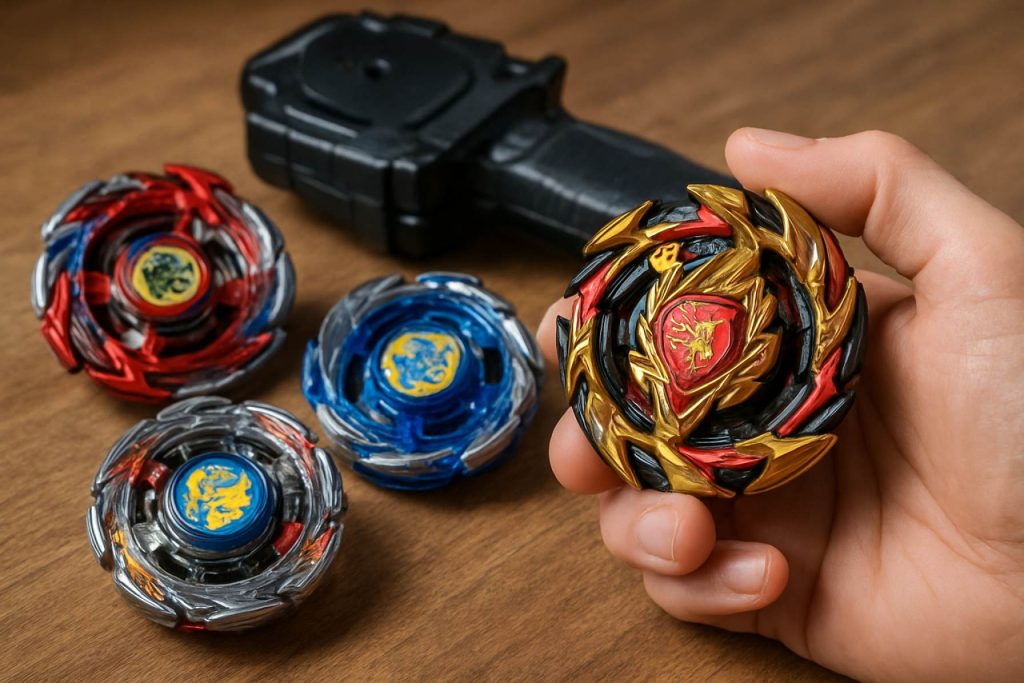
Unlocking the World of Beyblade: A Deep Dive into Collecting Rarities and Dominating Competitive Play. Discover the Strategies, Trends, and Future of This Spinning Phenomenon. (2025)
- Introduction: The Rise of Beyblade as a Global Hobby
- History and Evolution of Beyblade Products
- Types of Beyblades: From Classics to Limited Editions
- The Art and Science of Beyblade Collecting
- Competitive Play: Rules, Formats, and Global Tournaments
- Key Strategies for Building Winning Beyblade Combos
- Technology and Innovation: Burst Systems, Materials, and Customization
- Market Trends: Growth, Rarity, and Value Forecasts (2024–2029)
- Community and Culture: Clubs, Online Forums, and Official Events
- Future Outlook: Predicted Growth and the Next Generation of Beyblade
- Sources & References
Introduction: The Rise of Beyblade as a Global Hobby
Since its inception in the late 1990s, Beyblade has evolved from a simple spinning top toy into a global phenomenon, captivating enthusiasts of all ages. Originating in Japan, Beyblade was first introduced by TAKARA TOMY, a renowned Japanese toy manufacturer. The brand quickly gained international traction, especially after the launch of the animated series and subsequent expansion into North America and Europe. By 2025, Beyblade has firmly established itself as both a collectible hobby and a competitive sport, with a vibrant community spanning continents.
Beyblade collecting has become a significant aspect of the hobby, with fans seeking out rare and limited-edition tops, stadiums, and accessories. The intricate designs, evolving mechanics, and themed releases have contributed to a thriving secondary market and a culture of trading and showcasing prized collections. Collectors often focus on specific series, such as Beyblade Burst or Metal Fight, each offering unique features and innovations. The official product lines are meticulously cataloged and authenticated by TAKARA TOMY and its international partners, ensuring the integrity and value of collectible items.
Parallel to collecting, competitive Beyblade play has surged in popularity, transforming the pastime into an organized sport. Tournaments are held at local, national, and international levels, governed by organizations such as the World Beyblade Organization (WBO). The WBO, an independent global community, sets standardized rules, hosts events, and fosters a spirit of fair play and innovation. Competitive play emphasizes strategy, customization, and skill, as participants modify their Beyblades to optimize performance in official stadiums. The dynamic nature of battles, combined with the unpredictability of outcomes, has made Beyblade tournaments a compelling spectator event.
The rise of digital platforms and social media has further amplified Beyblade’s reach, enabling fans to connect, share strategies, and participate in virtual competitions. Official apps and online resources provided by Hasbro—the primary distributor of Beyblade products outside Japan—have made it easier for newcomers to learn the rules and for veterans to track their progress. As Beyblade enters 2025, its dual appeal as a collectible and a competitive sport continues to drive its growth, uniting a diverse, passionate global community.
History and Evolution of Beyblade Products
Beyblade, a spinning top toy line originally developed by the Japanese company Takara Tomy, has evolved significantly since its launch in 1999. The franchise quickly expanded beyond toys, spawning anime series, manga, and a global competitive scene. The history of Beyblade collecting and competitive play is deeply intertwined with the product’s evolution, reflecting changes in design, technology, and community engagement.
Early Beyblade products, known as the “Bakuten Shoot Beyblade” series, featured customizable tops with interchangeable parts, encouraging experimentation and collection. As the franchise grew, new generations such as “Beyblade Metal Fight” (Metal Fusion) and “Beyblade Burst” introduced advanced mechanisms, including metal components and burst systems, which added strategic depth to both collecting and competitive play. Each generation brought unique parts, limited editions, and region-exclusive releases, fueling a vibrant collector’s market. Collectors often seek rare Beyblades, special promotional items, and first-edition releases, with some items becoming highly valuable over time.
Competitive Beyblade play has been formalized through organized tournaments and leagues. The Takara Tomy company, as the original creator, has hosted official tournaments in Japan, while international markets have seen similar events organized by partners such as Hasbro, which distributes Beyblade in North America and other regions. The competitive scene is governed by standardized rulesets, often based on the latest product generation, and emphasizes skillful customization, launch technique, and tactical play. The introduction of the “Burst” system, where tops can explode apart during battle, added a new layer of excitement and unpredictability to competitions.
The global Beyblade community is supported by fan-driven organizations and online platforms, where enthusiasts share strategies, trade parts, and organize unofficial tournaments. The World Beyblade Organization (WBO), while not an official company, has played a significant role in fostering international competition and maintaining a comprehensive database of Beyblade products and tournament results. Official companies like Takara Tomy and Hasbro continue to innovate, releasing new series and special editions to keep both collectors and competitive players engaged.
As of 2025, Beyblade collecting and competitive play remain dynamic aspects of the franchise, driven by ongoing product innovation, a passionate global community, and the enduring appeal of customizable, skill-based battles.
Types of Beyblades: From Classics to Limited Editions
Beyblade collecting and competitive play have evolved significantly since the franchise’s inception in 1999, with a diverse array of Beyblade types captivating enthusiasts worldwide. The primary categories of Beyblades—Attack, Defense, Stamina, and Balance—each offer unique design features and performance characteristics, shaping both the collecting landscape and tournament strategies. Classic Beyblades, originating from the earliest “Bakuten Shoot Beyblade” series, are highly sought after by collectors for their nostalgic value and distinctive metal and plastic construction. These early models, produced by TAKARA TOMY, the official creator and manufacturer of Beyblade, are often considered foundational pieces in any serious collection.
As the franchise expanded, new generations introduced innovative mechanics and aesthetics. The “Metal Fight” (or “Metal Fusion”) series, for example, incorporated heavier metal parts, enhancing durability and battle performance. The subsequent “Burst” series revolutionized play with a burst mechanism, allowing Beyblades to explode apart during battle, adding unpredictability and excitement. Each generation has produced its own line of rare and limited-edition Beyblades, often released through special events, collaborations, or as tournament prizes. These limited editions, sometimes featuring unique color schemes, materials, or commemorative engravings, are highly prized among collectors and can command significant value on the secondary market.
Competitive play is governed by organizations such as the World Beyblade Organization (WBO), an international community that sets standardized rules, hosts tournaments, and maintains a global ranking system. Official tournaments typically require the use of authentic Beyblades produced by TAKARA TOMY or, in some regions, by Hasbro, which distributes Beyblade products outside Japan. Competitive players often customize their Beyblades by interchanging parts to optimize performance for specific battle types, a practice that has become a core aspect of both play and collecting.
Collectors and competitors alike value Beyblades not only for their playability but also for their craftsmanship, rarity, and historical significance. Limited editions, such as event-exclusive releases or anniversary models, are especially coveted. The interplay between collecting and competitive play continues to drive innovation and enthusiasm within the Beyblade community, ensuring that both classic and contemporary types remain integral to the hobby’s enduring appeal.
The Art and Science of Beyblade Collecting
Beyblade collecting has evolved into a nuanced hobby that blends nostalgia, engineering appreciation, and competitive ambition. Since its inception by TAKARA TOMY in 1999, Beyblade has grown from a simple spinning top toy into a global phenomenon, with collectors and players seeking out rare releases, limited editions, and high-performance parts. The collecting aspect is driven by several factors: the desire to own complete series, the pursuit of rare or region-exclusive Beyblades, and the appreciation of the intricate designs and technological innovations that each generation introduces.
Collectors often focus on specific lines, such as the original Bakuten Shoot Beyblade, Metal Fight Beyblade, or the more recent Beyblade Burst series. Each line features unique mechanisms and aesthetics, with Burst Beyblades, for example, incorporating a “burst” feature that causes the top to explode apart during battle, adding a new layer of excitement and collectibility. Limited edition releases, often tied to anniversaries or special events, are highly sought after and can command significant value in the secondary market. Authenticity and condition are paramount, with collectors favoring unopened packaging and original parts.
The science of Beyblade collecting intersects with competitive play, as many enthusiasts seek not only to display their collections but also to optimize their Beyblades for tournament performance. The World Beyblade Organization (WBO), a leading global community and governing body for Beyblade tournaments, sets official rules and standards for competitive play. This includes regulations on part combinations, weight limits, and stadium types, ensuring a level playing field and encouraging strategic customization. Competitive players analyze the physics of spin, weight distribution, and material durability to gain an edge, often experimenting with different combinations of energy layers, forge discs, and performance tips.
- Rarity and Value: Collectors track the release history and production numbers, with some Beyblades becoming valuable due to limited runs or unique features.
- Customization: Both collectors and competitors experiment with part swaps to create unique or high-performing combinations, guided by official compatibility charts from TAKARA TOMY.
- Community: Online forums and local clubs foster knowledge sharing, trading, and organized play, with the World Beyblade Organization providing a central hub for global engagement.
In 2025, Beyblade collecting and competitive play continue to thrive, driven by innovation from TAKARA TOMY and the vibrant, ever-evolving community organized by the World Beyblade Organization. The interplay between collecting and competition ensures that Beyblade remains both a cherished hobby and a dynamic sport.
Competitive Play: Rules, Formats, and Global Tournaments
Competitive Beyblade play has evolved into a structured and globally recognized activity, governed by official rules and supported by a vibrant tournament scene. The foundation of competitive play is built upon standardized rulesets, which ensure fairness and consistency across matches. The most widely adopted rules are established by the World Beyblade Organization (WBO), a leading international community and governing body for Beyblade tournaments. The WBO provides comprehensive guidelines on stadium types, launch techniques, part legality, and match procedures, which are regularly updated to reflect new product releases and community feedback.
Beyblade battles are typically conducted in specialized stadiums, with matches structured in various formats. The most common format is the “First to 3 Points” system, where players earn points by knocking out, bursting, or outspinning their opponent’s Beyblade. Other formats include round-robin, single-elimination, and double-elimination brackets, allowing for both casual and highly competitive play. The WBO also recognizes different Beyblade generations—such as Burst, Metal Fight, and Plastic—each with its own set of legal parts and unique gameplay mechanics.
Official tournaments are held at local, national, and international levels. Local events often serve as qualifiers for larger regional or national championships. The WBO sanctions hundreds of tournaments annually, providing a platform for players of all ages to compete and improve their skills. In addition to WBO events, TAKARA TOMY—the original creator and manufacturer of Beyblade—hosts the Beyblade Burst World Championship, a prestigious global tournament that brings together top players from around the world. These events are characterized by strict adherence to official rules, rigorous judging, and a strong emphasis on sportsmanship.
The competitive Beyblade scene is further enriched by the active participation of the community. Players often customize their Beyblades for optimal performance, experimenting with different combinations of layers, discs, and drivers to gain a strategic edge. Online forums and social media groups facilitate the exchange of strategies, tournament results, and rule updates, fostering a collaborative and dynamic environment. As Beyblade continues to grow in popularity, the competitive landscape is expected to expand, with new formats, technologies, and international collaborations shaping the future of organized play.
Key Strategies for Building Winning Beyblade Combos
Building winning Beyblade combos is a central pursuit for both collectors and competitive players, as the right combination of parts can dramatically influence performance in battle. The process involves understanding the core components of a Beyblade—namely the Energy Layer, Forge Disc, and Performance Tip (for Burst System Beyblades)—and how their attributes interact to create specific battle types: Attack, Defense, Stamina, and Balance. Each part is designed with unique characteristics that affect speed, spin direction, weight distribution, and burst resistance.
A key strategy is to first identify the desired battle type. For example, Attack types benefit from aggressive, fast-moving layers and flat, low-friction tips, while Defense types require heavier, more stable discs and rounded tips to absorb impacts. Stamina types prioritize smooth, low-resistance tips and balanced weight for prolonged spin, and Balance types combine features from the other categories for versatility. Collectors and players often analyze official part releases and tournament results to determine which combinations are currently most effective, as the metagame evolves with each new product wave.
Another important tactic is to consider the synergy between parts. For instance, pairing a heavy Forge Disc with a high-burst-resistance Layer can create a combo that withstands powerful attacks, while a sharp Performance Tip can enhance stamina but may reduce stability if not matched with the right Layer. Testing combos in practice battles is essential, as theoretical strengths may not always translate to real-world performance due to stadium conditions and launch technique.
Competitive players also pay close attention to the official rules and part restrictions set by organizations such as the World Beyblade Organization (WBO) and the product guidelines from Takara Tomy and Hasbro, the primary manufacturers of Beyblade products. These organizations regulate which parts are legal in tournaments and often introduce new formats or ban certain overpowered combinations to maintain balance in play.
Finally, successful combo building involves ongoing research and adaptation. Engaging with the global Beyblade community through forums, official events, and social media allows collectors and competitors to stay informed about emerging strategies, rare part releases, and rule changes. By combining technical knowledge, hands-on experimentation, and community insights, players can craft combos that maximize their chances of victory in both casual and official competitive play.
Technology and Innovation: Burst Systems, Materials, and Customization
The evolution of Beyblade technology has been central to both the collecting and competitive play communities, with innovations in burst systems, materials, and customization options driving engagement and strategy. Since its inception, Beyblade has been produced by TAKARA TOMY, a leading Japanese toy manufacturer, which has continually advanced the product line through new engineering and design concepts.
A major technological leap occurred with the introduction of the Burst System in 2015. Unlike earlier generations, Burst Beyblades are designed to come apart during battle when struck with sufficient force, adding a new layer of excitement and unpredictability to matches. This system not only enhances the competitive aspect but also increases the collectibility of individual parts, as players seek out components with optimal burst resistance or attack potential. The Burst System’s modular design allows for extensive customization, enabling players to interchange layers, discs, and drivers to create unique combinations tailored to specific strategies or tournament rules.
Material innovation has also played a significant role in Beyblade’s development. Early models primarily used plastic, but modern Beyblades incorporate a mix of high-grade polycarbonate, reinforced ABS, and die-cast metal alloys. The integration of metal parts, especially in the energy layers and forge discs, increases weight and stability, which can be crucial in competitive play. These advancements not only improve performance but also enhance the tactile and visual appeal for collectors, who often seek rare or limited-edition releases featuring unique materials or finishes.
Customization is at the heart of both collecting and competitive play. The official rules, maintained by organizations such as the World Beyblade Organization (WBO), encourage players to experiment with different part combinations within defined parameters. This has led to a vibrant metagame, where knowledge of part interactions, material properties, and burst mechanics is essential for success. Collectors, meanwhile, are drawn to the vast array of parts and special editions, often released in collaboration with events or anniversaries, further fueling the hobby’s appeal.
In 2025, the Beyblade community continues to thrive on the synergy between technological innovation and player creativity. The ongoing release of new systems and materials by TAKARA TOMY ensures that both competitive play and collecting remain dynamic, with each new generation offering fresh opportunities for strategy, discovery, and personal expression.
Market Trends: Growth, Rarity, and Value Forecasts (2024–2029)
The Beyblade collecting and competitive play market is experiencing notable growth as of 2025, driven by a resurgence in nostalgia, expanding global tournaments, and the introduction of innovative product lines. The market is shaped by both seasoned collectors seeking rare, vintage Beyblades and a new generation of players engaging in organized competitions. This dual interest is fueling demand for both legacy and contemporary Beyblade products.
Growth in the Beyblade market is closely tied to the activities of Hasbro and Takara Tomy, the two principal manufacturers. Both companies have continued to release new series and limited-edition Beyblades, often in collaboration with major events or anniversaries, which has contributed to a steady influx of new collectors and players. The expansion of official tournaments, such as those sanctioned by the World Beyblade Organization (WBO)—a leading global community and tournament organizer—has further cemented Beyblade’s status as both a collectible and a competitive hobby.
Rarity remains a key driver of value in the Beyblade collecting market. Limited-edition releases, event exclusives, and discontinued models from early generations (notably the original Bakuten Shoot Beyblade and Metal Fight Beyblade lines) are highly sought after. The value of these items is expected to appreciate over the 2024–2029 period, particularly as older products become increasingly scarce and as the collector base matures. The introduction of serialized or numbered Beyblades, as well as collaborations with popular franchises, is anticipated to further enhance rarity and desirability.
Forecasts for 2024–2029 suggest continued market expansion, with growth rates bolstered by digital engagement, such as online tournaments and trading platforms. The integration of app-based play and augmented reality features by manufacturers is expected to attract younger audiences and sustain interest. Additionally, the secondary market for rare Beyblades is projected to grow, with auction platforms and collector forums reporting rising transaction volumes and prices for high-demand items.
In summary, the Beyblade collecting and competitive play market is poised for robust growth through 2029, underpinned by product innovation, expanding tournament infrastructure, and the enduring appeal of rarity. The combined efforts of Hasbro, Takara Tomy, and the World Beyblade Organization are central to shaping these trends and ensuring the continued vitality of the Beyblade ecosystem.
Community and Culture: Clubs, Online Forums, and Official Events
Beyblade collecting and competitive play have fostered a vibrant global community, uniting enthusiasts of all ages through shared passion and friendly rivalry. Since its inception by TAKARA TOMY in Japan, Beyblade has evolved from a simple spinning top toy into a multifaceted hobby, encompassing both the thrill of competition and the joy of collecting rare and unique models.
Clubs and local meetups form the backbone of Beyblade’s grassroots culture. Across cities worldwide, dedicated groups gather in community centers, hobby shops, and schools to organize tournaments, trade parts, and discuss strategies. These clubs often serve as entry points for newcomers, providing guidance on rules, customization, and the nuances of competitive play. Many clubs are affiliated with larger organizations, such as the World Beyblade Organization (WBO), a leading fan-driven body that standardizes tournament formats, maintains global rankings, and fosters a sense of fair play and sportsmanship.
Online forums and digital platforms have further expanded the reach of Beyblade culture. Enthusiasts connect via dedicated websites, social media groups, and video-sharing platforms to exchange tips, showcase collections, and organize virtual tournaments. The WBO’s official forum is a central hub for international discussion, offering resources on customization, event listings, and a marketplace for trading rare Beyblades. These online spaces enable collectors to stay informed about new releases from TAKARA TOMY and Hasbro, the two primary manufacturers, and to share insights on the evolving metagame.
Official events, sanctioned by manufacturers and organizations like the WBO, are highlights of the Beyblade calendar. These tournaments, ranging from local qualifiers to world championships, attract competitors of all skill levels. Events are governed by standardized rulesets, ensuring fairness and consistency. Participants compete in various formats—such as single elimination, round robin, and team battles—using both stock and customized Beyblades. Prizes often include exclusive Beyblade models, trophies, and recognition within the community.
The culture surrounding Beyblade collecting and competitive play is characterized by inclusivity, creativity, and a spirit of friendly competition. Whether through local clubs, online forums, or official events, the community continues to thrive, driven by a shared enthusiasm for the game’s strategic depth and collectible appeal.
Future Outlook: Predicted Growth and the Next Generation of Beyblade
The future of Beyblade collecting and competitive play appears robust as the franchise continues to evolve, driven by both technological innovation and a dedicated global fanbase. As of 2025, Beyblade remains under the stewardship of TAKARA TOMY, the original Japanese toy manufacturer responsible for the brand’s creation and ongoing development. The company’s commitment to introducing new Beyblade generations—such as the Burst and X series—ensures a steady influx of fresh designs, mechanics, and collectible items, which in turn fuels collector enthusiasm and market activity.
The collecting aspect is expected to grow, particularly as older series become vintage and new releases incorporate advanced materials and customization options. Limited-edition Beyblades, collaboration models, and region-exclusive releases are likely to remain highly sought after, driving secondary market activity and fostering a culture of rarity and prestige among collectors. The increasing digitization of the hobby, including official apps and digital battle platforms, is also anticipated to enhance the collecting experience by allowing users to track, showcase, and trade their collections virtually.
On the competitive front, the future outlook is equally promising. The World Beyblade Organization (WBO), a leading global community and tournament organizer, continues to expand its reach, standardizing rules and facilitating international competitions. The integration of smart technology—such as app-connected launchers and real-time battle analytics—may further professionalize the competitive scene, attracting new participants and spectators. Official tournaments, both in-person and online, are expected to grow in scale and frequency, supported by partnerships with educational institutions and youth organizations.
Looking ahead, the next generation of Beyblade is likely to emphasize interactivity, customization, and inclusivity. Innovations in materials science and engineering could yield more durable and dynamic tops, while augmented reality (AR) and virtual reality (VR) experiences may redefine how battles are conducted and enjoyed. The franchise’s adaptability to changing play patterns and digital trends positions it well for continued relevance among both collectors and competitive players.
In summary, Beyblade collecting and competitive play are poised for sustained growth through 2025 and beyond, underpinned by ongoing product innovation from TAKARA TOMY and the organizational efforts of the World Beyblade Organization. The convergence of physical and digital play, alongside a vibrant collector community, ensures that Beyblade will remain a dynamic and engaging hobby for the next generation.



